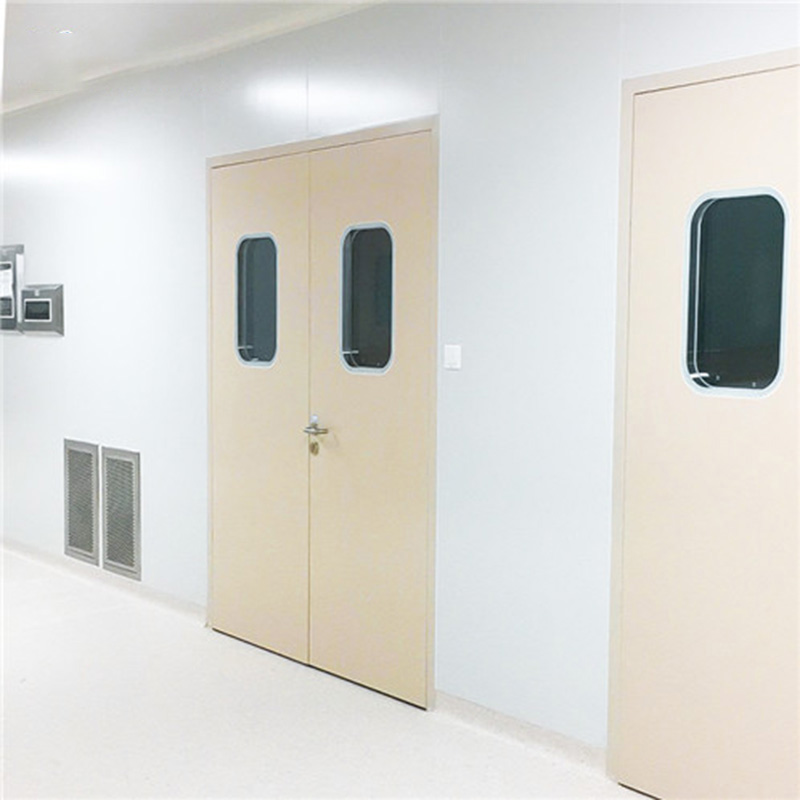Designing cleanroom doors for environments with fluctuating temperature and humidity requires careful consideration to ensure they maintain both sealing efficiency and operational reliability.
Material Selection
Thermal Stability: The materials used for the door frame, panels, and seals must be able to withstand temperature variations without warping, cracking, or losing structural integrity. Materials like stainless steel, aluminum, and certain composite materials are ideal because they offer good thermal stability.
Humidity Resistance: Choose materials for door components that are resistant to moisture absorption, corrosion, and microbial growth. Metals like stainless steel are non-corrosive, while special coatings (e.g., powder coating) can also enhance moisture resistance.
Seal Materials: Seals made from materials like silicone, EPDM (Ethylene Propylene Diene Monomer), or polyurethane are suitable because they maintain flexibility and durability under varying temperature and humidity conditions. These materials also help prevent air and particle infiltration.
Thermal Insulation
Insulated Door Panels: In environments where temperature fluctuations are significant, doors should have insulated panels to prevent heat loss or gain. These insulated panels help maintain internal conditions and reduce the burden on HVAC systems.
Thermal Breaks: Incorporating thermal breaks into the door design can help prevent heat transfer between the exterior and interior of the cleanroom, reducing condensation risks and maintaining stable internal conditions.
Condensation Control
Anti-Condensation Features: Temperature and humidity fluctuations can cause condensation on the door surfaces, which could lead to contamination. To mitigate this, consider using doors with built-in anti-condensation features, such as heated door panels or moisture-resistant coatings.
Drainage Systems: Some cleanroom doors have integrated drainage channels at the bottom to manage condensation effectively, preventing water from collecting at the door’s base, which could create hygiene and safety concerns.

Sealing Mechanisms
Compression and Flexibility: Seals must be designed to remain flexible across a wide temperature and humidity range. Seals that harden or lose elasticity at low temperatures, or become too soft in high heat, will fail to provide an effective barrier.
Effective Seal Compression: The sealing mechanism needs to be able to maintain a proper compression force under varying temperature and humidity conditions to prevent air or particle leakage.
Specialized Gaskets: Consider gaskets or seals that are specifically designed for extreme environments. For example, some cleanroom doors use dual-seal systems where a soft, flexible seal is complemented by a firmer seal that ensures durability over time.
Pressure Regulation
Temperature-Dependent Pressure Differences: As temperatures fluctuate, air density and internal pressure can vary, affecting the cleanroom's airflow dynamics. The door design must account for these changes to maintain proper sealing and airflow, especially if the cleanroom operates under positive or negative pressure.
Automatic Pressure Regulation: Automated door systems that adjust for internal pressure fluctuations can help minimize the risk of leaks when the environment shifts.
Door Operation and Automation
Smooth Operation in Varying Conditions: Ensure that the door mechanisms (manual or automatic) operate smoothly despite temperature and humidity changes. For instance, automatic doors should be able to open and close quickly and without resistance, even when the door seals are compressed under varying conditions.
Sensor Integration: Automated door systems should include sensors to detect changes in humidity or temperature and adjust door operation accordingly (e.g., opening more slowly in high-humidity conditions to prevent air pressure imbalances).
Airflow and Ventilation
Minimizing Disruption to HVAC Systems: Since temperature and humidity fluctuations can affect the HVAC system, the door should be designed in such a way that it doesn't disrupt the airflow or create uneven pressure zones when opened. This requires careful integration with the cleanroom's overall airflow design.
Airflow Balancing: When doors are frequently opened or closed in environments with fluctuating temperature and humidity, airflow balancing becomes even more critical. The door design should incorporate features that ensure minimal disruption to the overall cleanroom atmosphere.
Energy Efficiency
Minimizing Heat Transfer: For cleanrooms in temperature-sensitive environments, energy efficiency is a key concern. Doors with good thermal insulation and low heat transfer rates can help maintain internal conditions and reduce HVAC energy consumption.
Sealing Gaps: Even small gaps in seals or door frames can lead to significant heat loss or gain. Ensuring tight seals, even in extreme conditions, will help maintain energy efficiency.
Maintenance and Longevity
Routine Inspection: In fluctuating conditions, the seals and materials on cleanroom doors are subjected to more stress and wear. Regular inspections and maintenance of seals, gaskets, and panels are essential to ensure ongoing effectiveness and to prevent failures due to environmental extremes.
Material Durability: High-quality materials that resist aging, cracking, or degrading due to environmental stress are essential for ensuring longevity. Ensuring the door is designed for easy inspection and replacement of seals can help extend its lifespan in variable conditions.
Customized Features
Thermal Expansion Considerations: As temperature fluctuates, materials expand and contract. To accommodate this, the door system may need to include adjustable features (e.g., telescoping seals or sliding tracks) to allow for slight movement without compromising the integrity of the seal.
Modular Design: A modular door system can be advantageous in environments with extreme fluctuations, allowing for easier replacements or upgrades of specific components like seals, panels, or automation systems.

 English
English русский
русский Español
Español





